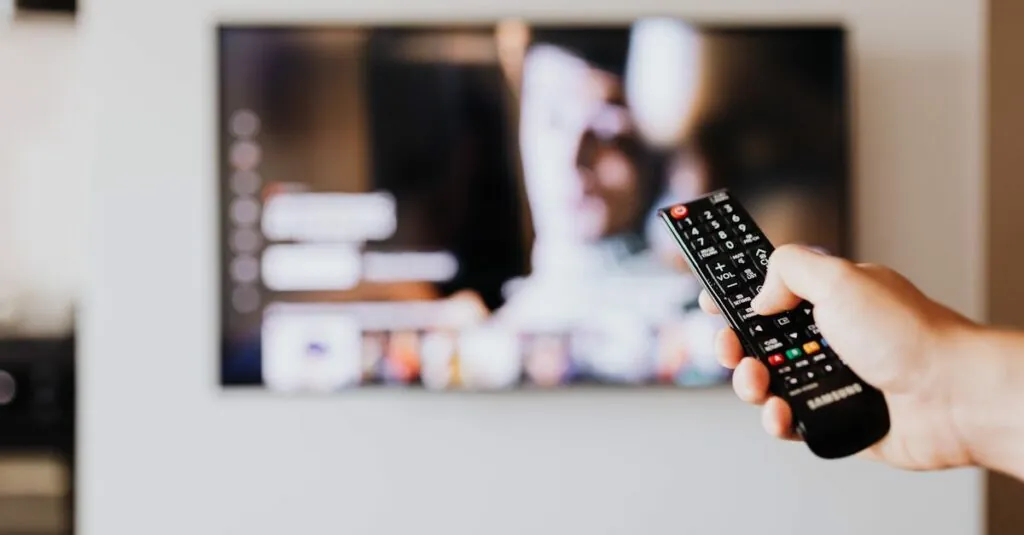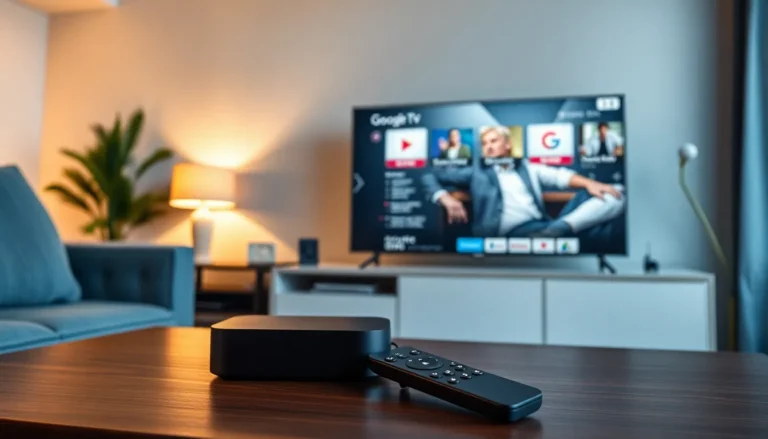In a world where binge-watching is practically a sport, the battle between cable TV and streaming services has never been fiercer. On one side, you’ve got cable, clinging to its bulky boxes and endless commercials like a cat to a sunbeam. On the other, streaming services swoop in with their sleek interfaces and on-demand content, making viewers feel like they’ve hit the jackpot.
But which option reigns supreme? Is it time to cut the cord and embrace the freedom of streaming, or does the nostalgic charm of cable still hold a place in our hearts? As viewers navigate through this digital landscape, they’re faced with choices that could either lead to endless entertainment or a streaming subscription hangover. Buckle up as we dive into the pros and cons of each, helping you decide whether to stick with the old guard or join the streaming revolution.
Table of Contents
ToggleOverview of Cable TV
Cable TV provides a traditional platform for entertainment, offering a variety of channels and programming through a subscription model. Established decades ago, it remains a prominent choice for numerous households.
History of Cable Television
Cable television began in the late 1940s, originally created to improve reception in rural areas with minimal broadcast signals. By the 1970s, cable became popular for its expanded offerings beyond local channels. Notably, the launch of HBO in 1972 marked a significant shift, introducing premium channels and original content. As technology advanced, cable companies began offering bundled services, including internet and phone options, which further solidified their position in the entertainment landscape.
Current Market Trends
Today, cable TV faces fierce competition from streaming services, prompting changes in viewer behavior. A 2022 report indicated that approximately 60% of U.S. households still subscribe to cable. However, a significant rise in cord-cutting has emerged, attributed to the increasing popularity of on-demand content. Cable providers now adapt by offering flexible packages tailored to audience preferences. Many companies invest in streaming options to attract younger audiences raised on digital content, ensuring continued relevance in a rapidly evolving market.
The Rise of Streaming Services
Streaming services have transformed how audiences consume content. These platforms offer flexibility, allowing viewers to watch shows and movies anytime, anywhere.
Popular Streaming Platforms
Numerous streaming platforms dominate the market. Netflix, founded in 1997, offers a vast library of original content and licensed programming. Amazon Prime Video provides access to movies and exclusive series for Prime members. Disney+ attracts families with beloved franchises like Marvel and Star Wars. Hulu features current season episodes from major networks alongside original content. HBO Max combines HBO’s premium programming with additional movies and shows. Each platform caters to different demographics, enhancing viewer choice.
Growth and Consumer Adoption
Streaming services have seen rapid growth in recent years. In 2022, over 80% of U.S. households subscribed to at least one streaming service, reflecting increased consumer preference for on-demand options. Younger audiences prefer streaming, with more than 70% of millennials choosing it over cable TV. Economic factors also drive this shift, as subscription costs often fall below traditional cable packages. With increased access to high-speed internet, watching content on various devices has never been easier. Audience habits continue to evolve, favoring the convenience and personalization that streaming offers.
Comparison of Cable TV and Streaming
Cable TV and streaming services represent two distinct approaches to content delivery. Each option carries unique advantages and drawbacks.
Cost Analysis
Cable TV generally requires installation fees and monthly subscriptions, often starting at around $100 per month. Users face additional costs for premium channels or bundled services. In contrast, streaming services offer varied pricing models, starting as low as $10 per month. Many platforms provide free trials, allowing users to explore content before committing. As of 2022, the average household spent approximately $56 per month on streaming subscriptions, highlighting a cost-effective alternative to cable.
Channel Selection and Content Variety
Cable TV offers a broad range of channels but often includes numerous commercials. Standard packages may include around 200 channels, catering to diverse interests. Streaming platforms provide original content alongside a selection of licensed titles, significantly increasing content variety. Services like Netflix and Hulu invest heavily in exclusive programming, appealing to niche audiences. With many streaming options, viewers access thousands of titles, satisfying different tastes.
User Experience and Accessibility
Cable TV requires equipment like set-top boxes and has geographic restrictions, often limiting viewing. User experience frequently involves navigating through cumbersome menus and commercial interruptions. Streaming services, however, provide an interface optimized for ease of use. Subscribers can watch shows on various devices, including smartphones, tablets, and smart TVs. Instant access to content anywhere with a reliable internet connection offers significant convenience, enhancing overall satisfaction.
Advantages of Cable TV
Cable TV offers distinct advantages that appeal to many viewers. One significant benefit lies in its reliability and stability, often providing consistent service without disruptions. Service interruptions due to weak internet connections rarely occur. Subscribers enjoy a stable signal even during inclement weather, ensuring uninterrupted viewing experiences.
Reliability and Stability
Reliability defines the cable TV experience. Consistently strong signals contribute to seamless viewing without buffering or loading delays. Users benefit from dedicated bandwidth, which ensures that multiple devices can connect simultaneously without loss of quality. Reliability influences viewer satisfaction, especially during high-demand events like award shows or live sports, where a stable connection enhances enjoyment.
Live Programming and Sports
Live programming stands out as a crucial draw of cable television. Cable services deliver real-time content, making it a top choice for sports enthusiasts. Major leagues and events, like the NFL and NBA, frequently air on cable channels. Many sports fans prefer the live broadcast experience, missing the thrill if they stream games later. Local news also thrives on cable, providing timely updates unavailable on most streaming platforms.
Benefits of Streaming Services
Streaming services provide significant advantages over traditional cable TV. They offer expansive libraries of on-demand content, ideal for viewers who prefer to watch shows and movies at their own pace.
On-Demand Content
On-demand content allows subscribers to choose specific titles anytime, promoting a personalized viewing experience. Streaming platforms host vast selections of movies, series, and documentaries, meeting diverse tastes. For instance, Netflix boasts over 4,000 titles, while Amazon Prime features an extensive catalog, including exclusive originals. Audiences access entire seasons at once, enabling binge-watching without interruptions common in cable programming.
Flexibility and Convenience
Flexibility and convenience further enhance the appeal of streaming services. Viewers can watch content on various devices, including smartphones, tablets, and smart TVs. Watching becomes possible from virtually anywhere, whether at home or on the go. Subscriptions typically lack lengthy contracts, allowing users to switch services or cancel without consequences. Many platforms also offer offline viewing options, letting audiences download and enjoy their favorite titles without needing an internet connection. Overall, the convenience of streaming aligns with modern lifestyles that value accessibility and variety.
The choice between cable TV and streaming services ultimately hinges on individual preferences and viewing habits. While cable offers reliability and a comprehensive range of live programming, streaming services provide unmatched flexibility and an extensive library of content. As technology continues to evolve, viewers must weigh the benefits of each option against their lifestyle and budget.
With the growing trend of cord-cutting and the increasing popularity of streaming platforms, it’s clear that the landscape of television consumption is changing. This ongoing competition will likely drive both cable providers and streaming services to innovate, ensuring that viewers have access to the best possible entertainment experiences.








